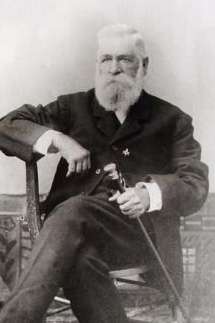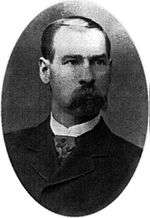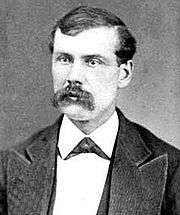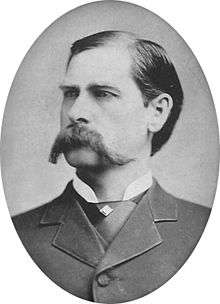Nicholas Porter Earp
| Nicholas Porter Earp | |
|---|---|
 | |
| Born |
September 6, 1813 Lincoln County, North Carolina, United States |
| Died |
February 12, 1907 (aged 93) Sawtelle, California, United States |
| Occupation | Soldier, farmer, cooper, constable, bootlegger, wagon-Master, teacher |
| Spouse(s) | Abigail Storm, Virginia Cooksey, Annie Elizabeth Cadd |
| Children | Newton, Mariah Ann, James, Virgil, Martha, Wyatt, Morgan, Warren, Virginia Ann, and Adelia Douglas Earp |
| Parent(s) | Walter Earp and Martha Ann Early |
Nicholas Porter Earp (September 6, 1813 – February 12, 1907) was the father of well-known Western lawmen Virgil, Wyatt, and Morgan, and their lesser-known brothers James and Warren Earp. He was a justice of the peace, a farmer, cooper, constable, bootlegger, wagon-master, and teacher.
Early family life and military service
Nicholas Earp was born in Lincoln County, North Carolina, to Walter Earp (b. 1787, Montgomery County, Maryland – d. January 30, 1853) and Martha Ann Early (b. August 28, 1790, Avery County, North Carolina – d. September 24, 1881). The Earp family was of English and Scotch-Irish descent.[1] The first Earp immigrant to the American colonies was Thomas Earp Jr., who arrived in Anne Arundel County on July 6, 1674, as an indentured servant from Ireland. He is buried in St. Anne's Parish in Annapolis.[2] Nicholas was named for a circuit-riding judge in Kentucky.
Nicholas' father Walter Earp was a school teacher, a Justice of the Peace in Monmouth, Illinois[3] and a Methodist Episcopal preacher. Walter Earp was born in Montgomery County, Maryland in 1787. He was a fifth-generation Marylander and the fourth great-grandson of Thomas Earp, Sr. (1631–1720), an Ulsterman who emigrated from the barony of Fews in County Armagh, Northern Ireland to Maryland. Nicholas' mother, Martha Ann Early, was born in Avery County, North Carolina, on August 28, 1790. Nicholas was the third of ten children; his siblings include six brothers: Lorenzo Dow, Josiah Jackson, James Kelly, Francis Asbury, Jonathan Douglas and Walter C (twins); as well as three sisters: Elizabeth, Mary Ann, and Sarah Ann.
Soon after his birth, his family moved from Virginia to Hartford, Kentucky in 1813, where Nicholas spent the rest of his childhood. As a young man, Nicholas served in the Black Hawk War of 1831 and later was a sergeant in the Mexican-American War. During the Mexican-American War Nicholas served under Captain Wyatt Berry Stapp of the Illinois Mounted Volunteers. Nicholas named his fourth son after him. During the Civil War, Nicholas also served in Iowa as a provost marshal for recruitment. This included his own sons Newton, James, and Virgil who fought for the Union Army. He originally intended to become a lawyer like his father before moving his law practice and his family from North Carolina to Kentucky, where he took up farming. He was also a cooper and sheriff.
First marriage
On December 22, 1836, in Hartford, Nicholas Porter married Abigail Storm, the daughter of Peter and Anna Maria (Lehman) Sturm (September 21, 1813, in Ohio County, Kentucky – October 8, 1839 Ohio County, Kentucky) who was the great-granddaughter of German immigrants who had originally settled in Frederick, Maryland. Their children: on December 22, 1836 in Hartford, Kentucky. They had two children:
- Newton Jasper Earp (October 7, 1837 Ohio County, Kentucky – December 18, 1928 Sacramento, California). Married Nancy Jane (Jennie) Adam.
- Mariah Ann Earp (February 12 – December 13, 1839), died two months after her mother at the age of ten months.
Abigail died on October 8, 1839.
Second marriage

On July 30, 1840, Nicholas married Virginia Ann Cooksey in Hartford, Kentucky.[4] They had eight children:
- James Cooksey Earp (June 28, 1841 in Hartford, Kentucky — January 25, 1926 in Los Angeles, California)[5]
- Virgil Walter Earp (July 18, 1843 in Hartford, Kentucky — October 19, 1905 in Goldfield, Nevada).
- Martha Elizabeth Earp (September 25, 1845 in Kentucky — May 26, 1856 in Monmouth, Illinois).
- Wyatt Berry Stapp Earp (March 19, 1848 in Monmouth, Illinois — January 13, 1929 in Los Angeles, California).
- Morgan Seth Earp (April 24, 1851 in Pella, Iowa — March 18, 1882 in Tombstone, Arizona).
- Baxter Warren Earp (always known as Warren) (March 9, 1855 in Pella, Iowa — July 6, 1900 in Willcox, Arizona).
- Virginia Ann Earp (February 28, 1858 in Marion County, Iowa — October 26, 1861 in Pella, Iowa).
- Adelia Douglas Earp (June 16, 1861 in Pella, Iowa — January 16, 1941 in San Bernardino, California).
Relocates to Iowa
In March 1849,[6] Nicholas Earp joined about one hundred others from Monmouth County, Illinois for a trip to California, where he planned to look for good farm land, not gold. He decided to move to San Bernardino County in the southern part of the state.[7] Nicholas returned to Illinois and the family left for California but their daughter Martha, became ill and died. Nicholas changed plans and moved to Pella, Iowa.[7]
Various occupations
Their new farm in Pella, Iowa, consisted of 160 acres (0.65 km2), 7 miles (11 km) was northeast of Pella, Iowa.[8] Eight years later, on March 4, 1856, Nicholas sold his Pella, Iowa, farm to Aquillin Waters Noe (who resold it on the same day to Hiram Zenas Webster) and the family returned to Monmouth, Illinois, where Nicholas found that nobody needed his services as cooper or farmer.
Unable to find work, Nicholas was elected as the town constable, which he served as for about three years. In 1859, he was tried and convicted of bootlegging. Nicholas was unable to pay the court-imposed fines following his trial, and a lien was levied against the Earp's property. On November 11, 1859, the property was sold at auction. Two days later, the Earps left Monmouth and returned to Pella.
Nicholas apparently made frequent travels to Monmouth throughout 1860 to confirm and conclude the sale of his properties and to face several lawsuits for debt and accusations of tax evasion. On May 12, 1864, the Earp family joined a wagon train heading to California. According to the diaries of Utah immigrants in the wagon train, Nicholas was one of the wagon-masters on their overland trek.
Civil War service
After the American Civil War began, Newton, James, and Virgil joined the Union Army on November 11, 1861. While his father was busy recruiting and drilling local companies, Wyatt, along with his two younger brothers, Morgan and Warren, were left in charge of tending the 80-acre (32 ha) corn crop. Only 13 years old, Wyatt was too young to enlist, but he tried on several occasions to run away and join the army. Each time his father found him and brought him home. James was severely wounded in Fredericktown, Missouri, and returned home in the summer of 1863. Newton and Virgil fought several battles in the east before returning home.[9]
Moves to California
On May 12, 1864, the Earp family joined a wagon train heading to California. Nicolas Earp joined with three other families from Pella, the Rousseaus, the Hamiltons, and the Curtises, and on May 12, 1864, they began a wagon trip to California. They took their children Wyatt, Jim, Morgan, Warren, and Adelia. Seven more wagons joined them during the trip to San Bernardino, California, where they arrived on December 17, 1864. Nicholas rented a farm on the banks of the Santa Ana River near present-day Redlands.[10]
Within the next year Virgil got a job driving a freight wagon to Salt Lake City and took Wyatt with him. Afterward they took jobs with the Union Pacific, which was building the Transcontinental Railroad west from Omaha, Nebraska. Virgil worked as a teamster and Wyatt manned a pick and shovel. Not long after their brothers Jim and Morgan left the family in San Bernardino and heading for the mining towns of Montana.[10]
In spring 1868, the Earps returned to the mid-west and settled in Lamar, Missouri, where Nicholas became the local constable.[11] By November 17, 1869, Nicholas resigned to become Justice of the Peace. His son Wyatt, who had been studying the law, was immediately appointed constable in place of his father.
Some time prior to 1880, Nicholas and Virginia Earp moved back to California, settling in San Bernardino County. The 1880 United States Census shows the Nicholas Earp household included Warren and Morgan and his wife Louisa ("Lou"). Nicholas was recorded as a farmer. Nicholas was also one of the founders of the San Bernardino Society of California Pioneers.
Third marriage and death
After Virginia's death on January 14, 1893 in San Bernardino, 80 year old Nicholas married Annie Elizabeth Cadd on October 14 of the same year. His new wife, the widow of Ambrose Peck Alexander (1825–1884), was 50 years old.[12][13] She had been born in 1842 in Preston Bissett, Buckingham, England. She died in 1931 and is buried near Virginia and Nellie Earp (wife of son James Earp) at the Pioneer Cemetery in San Bernardino.
Nicholas Earp died at The Soldier's Home in Sawtelle, California, on February 12, 1907, shortly after he was elected to the Los Angeles County court. He is buried in West Los Angeles at the Los Angeles National Cemetery. He had outlived six of his ten children.[14]
Descendants
Three of Nicholas' sons—Virgil, Wyatt, and Morgan—became well-known lawmen as a result of their part in the Gunfight at the O.K. Corral.
 James Earp |
 Virgil Earp |
 Wyatt Earp |
 Morgan Earp |
 Warren Earp |
Newton Earp
Newton married Nancy Jane (Jennie) Adam sometime between 1865 and 1868. They had five children.
James Earp
James Cooksey Earp enlisted in the Union Army at the outbreak of the American Civil War. He was wounded on October 31, 1861 in a battle near Fredericktown, Missouri, and lost the use of his left arm. He was discharged in March, 1863.[15] Newton and Virgil served until the end of the war.[5] He married former prostitute Nellie "Bessie" Ketchum, in April 1873. He served briefly as a deputy marshal in Dodge City, Kansas under Marshal Charlie Bassett. On December 1, 1879, he and Nellie joined his brothers Wyatt and Virgil and their wives in Tombstone in the Arizona Territory. He was not present at the Gunfight at the O.K. Corral on October 26, 1881.[5]
On December 28, 1881, his brother Virgil Earp was ambushed and gravely wounded. He survived but lost use of his left arm. On March 18, 1882, his brother Morgan Earp was assassinated in a billiard parlor. James accompanied Morgan's body to the family home in Colton, California.[16]
James then lived for a short time in Shoshone County, Idaho, until settling permanently by 1890 in California. James Earp died of natural causes in San Bernardino, California, on January 25, 1926. He is interred there at the Mountain View Cemetery.
Virgil Earp
Virgil eloped at age sixteen with 16-year-old Dutch immigrant Magdalena C. "Ellen" Rysdam (born November 25, 1842 in Utrecht, Netherlands – died May 3, 1910 in Cornelius, Oregon). They remained together for a year in spite of her parents' (Gerrit Rysdam and Magdalena Catrina Van Velzen) disapproval of her choice. Nellie was born two weeks before Virgil enlisted to serve with the Union forces in the Civil War. During the war, Ellen received news that Virgil had died and left Iowa.
Virgil was discharged from the military on June 26, 1865 and returned to Iowa, but he could not locate Ellen. Five years later, he married Rosella Dragoo (b. January 3, 1845, France) on August 28, 1870 in Lamar, Missouri.[11] His father, Justice of the Peace Nicholas Earp, married them. There are no further records of Rosella or their marriage.[17][18] Virgil later met Alvira "Allie" Sullivan from Florence, Nebraska, in 1874. They were never married but remained together the remainder of his life.
On November 27, 1879, U.S. Marshal Crawley Dake appointed Virgil as Deputy U.S. Marshal for the eastern portion of Pima County. He was instructed by Dake to move to Tombstone to help resolve ongoing problems with outlaw Cowboys. But the job didn't pay much. He was mostly on call helping county and city officials.[19]:113
On October 30, 1880, after town marshal Fred White was accidentally shot and killed by outlaw and gunman "Curly Bill" Brocius, Virgil was for a while both Tombstone town marshal and Deputy U.S. Marshal.[19]:114[20] While holding these two offices Virgil, his brothers Wyatt and Morgan, and Doc Holliday confronted the Cowboys in a narrow lot on Fremont Street. Virgil was not expecting a fight. He later testified that when he saw the Cowboys, he immediately commanded them to "Throw up your hands, I want your guns!"[21] But general shooting broke out almost immediately. Witnesses were conflicted about who fired first. During the gunfight, Billy Clanton and both McLaury brothers were killed. Virgil was shot through the calf (he thought by Billy Clanton). Three days after the O.K. Corral gunfight, the city council suspended Virgil as city marshal pending outcome of the preliminary hearing. Virgil was eventually exonerated of wrongdoing, but his reputation suffered thereafter.
On December 28, 1881, three men hidden in the upper story of an unfinished building across Allen street from the hotel ambushed Virgil from behind as he walked from the Oriental Saloon to his room. Virgil was hit in the back and left arm by three loads of double-barreled buckshot from about 60 feet (18 m).[22] He was seriously wounded and Dr. George E. Goodfellow was forced to remove 4 inches (100 mm) of shattered humerus bone from Virgil's left arm, leaving his arm permanently crippled.[23]
In 1898 Virgil was startled to receive a letter from a Mrs. Levi Law, who turned out to be his long-lost daughter who had disappeared with her mother while Virgil fought in the Civil War. He visited her and his first wife in Portland, Oregon in 1898.[11]
Wyatt Earp
Wyatt Berry Stapp Earp was married three times. His first wife died less than a year after they were married while carrying their first child. Wyatt held a variety of jobs during his life. He was a gambler, lawman, buffalo hunter, saloon keeper, gold/copper miner, pimp,[24] and boxing referee. He arrived with his brothers Virgil and Morgan in Tombstone, Arizona Territory on December 1, 1879. They became embroiled in a conflict with outlaw Cowboys that led to a confrontation and shootout on October 26, 1881, later known as the Gunfight at the O.K. Corral.[25]:115[26]
Wyatt developed a reputation as a sportsman as well as a gambler.[19]:50 Wyatt was dismayed about the controversy that continually followed him. He wrote a letter to John Hays Hammond on May 21, 1925, telling him "notoriety had been the bane of my life".[27]
Morgan Earp
Morgan Seth Earp joined his brothers Virgil and Wyatt in Tombstone, Arizona Territory on December 1, 1879. He became embroiled in the conflict between the Earp lawmen and a loose federation of outlaw Cowboys. He took part in the Gunfight at the O.K. Corral and was wounded. He was charged by Ike Clanton with murder, but during a month-long preliminary hearing, Judge Wells Spicer ruled that they had acted within the law and dismissed the charges.
Late Saturday night, March 18, 1882, Morgan was ambushed and killed after returning from a musical at Schieffelin Hall. He was playing a late round of billiards at the Campbell & Hatch Billiard Parlor against owner Bob Hatch. He and the other Earp brothers had received death threats earlier in the day.[28]:38 The assailant shot Morgan through a window in a door that opened onto an alley between Allen and Fremont Streets. Morgan was struck in the right side and the bullet shattered his spine, passed through his left side, and lodged in the thigh of mining foreman George A.B. Berry.[29] He died within the hour.
Adelia Earp
Adelia married William Thomas Edwards in Rice County, Kansas in 1877. William Edwards died on May 3, 1919, in San Bernardino County, California. Adelia and William had three children:
- Nicholas Edwards
- Estelle Josphine Edwards
- Mary Virginia Edwards (c. 1880–1935).
References
- ↑ "Wyatt Earp Family History". Retrieved June 26, 2011.
- ↑ Burris, Joe (May 10, 2005). "The Eastern Earps". Baltimore Sun. Retrieved October 20, 2014.
- ↑ McLelland, G.S. "Wyatt Earp". Archived from the original on December 22, 2012. Retrieved June 26, 2011.
- ↑ Jane Eppinga (2010). Tombstone. Arcadia Publishing. p. 41. Retrieved July 1, 2011.
- 1 2 3 "James Earp". Archived from the original on 2014-01-03.
- ↑ "Where was Nicholas Earp in 1849–50?".
- 1 2 Gormley, Myra Vanderpool (2013) [1994]. "Wild West Personalities Produce Bang-Up Pedigree". Genealogy Magazine. Retrieved March 25, 2014.
- ↑ Urban, William. "Nicholas Earp". Archived from the original on March 16, 2009. Retrieved April 11, 2011.
- ↑ "Wyatt Earp: Timeline – Childhood to Wichita". Archived from the original on July 5, 2012. Retrieved April 11, 2011.
- 1 2 Cataldo, Nicholas R. "Wyatt Earp in San Bernardino". Retrieved April 16, 2013.
- 1 2 3 Paul, Jan S.; Carlisle, Gene (June 12, 2006). "Frontier Lawman Virgil Earp". Wild West. Retrieved May 9, 2011.
- ↑ "Judge Earp Weds". 2 (32). San Francisco, California: The Morning Call. October 15, 1893.
- ↑ "Ambrose Peck Alexander". January 28, 2010.
- ↑ "Hears of Death of Earp". 33 (28). Los Angeles Herald. 29 October 1905. Retrieved October 2, 2014.
- ↑ "The Nicholas Porter Earp Family". International Blacksheep Society of Genealogists (IBSSG). Archived from the original on June 12, 2009. Retrieved May 7, 2011.
- ↑ "Another Assassination Frank Stilwell Found Dead this Morning Being Another Chapter in the Earp-Clanton Tragedy". Tombstone, Arizona: The Tombstone Epitaph. March 27, 1882. p. 4.
- ↑ "The Earp / Holliday Women". Retrieved June 23, 2011.
- ↑ "The Earp Brothers". Retrieved June 23, 2011.
- 1 2 3 Marks, Paula Mitchell (1996). And Die in the West: the Story of O.K. Corral Gunfight (Oklahoma Paperbacks ed.). Norman, Okla.: University of Oklahoma Press. ISBN 978-0-8061-2888-7.
- ↑ "Wyatt's House". Retrieved February 11, 2011.
- ↑ Linder, Douglas, ed. (2005). "Testimony of Virgil Earp in the Preliminary Hearing in the Earp Case". Famous Trials: The O. K. Corral Trial. Retrieved 6 February 2011. From Turner, Alford (Ed.), The O. K. Corral Inquest (1992)
- ↑ "An Interview With Virgil W. Earp". ARIZONA AFFAIRS. Archived from the original on April 23, 2009. Retrieved May 25, 2011.
Originally reported in the San Francisco Examiner on May 27, 1882
- ↑ Rose, John. "Wyatt's House". Retrieved February 11, 2011.
- ↑ Flanzbaum, Hilene (March 2, 2013). "The Jewish First Lady at Legendary Lawmaker Wyatt Earp's O.K. Corral". Archived from the original on April 19, 2015. Retrieved April 20, 2015.
- ↑ Tefertiller, Casey. Wyatt Earp - Life Behind The Legend. John Wiley & Sons, Inc.
- ↑ "Earp Historical Timeline Page 12 The Final Years". Archived from the original on February 19, 2008.
- ↑ Dworkin, Mark. "Charlie Siringo, Letter Writer". Western Outlaw Lawman Association Journal. Winter 2003, Vol. XI (4): 16–18.
- ↑ Dodge, Fred; Lake, Carolyn (1999). Under Cover for Wells Fargo The Unvarnished Recollections of Fred Dodge. Norman, Oklahoma: University of Oklahoma Press. p. 336. ISBN 978-0-8061-3106-1.
- ↑ Johnson, Paul Lee. The McLaurys in Tombstone, Arizona : an O. K. Corral obituary (1st ed.). Denton, Tex.: University of North Texas Press. p. 281. ISBN 978-1574414509.
Further reading
Gatto, Steve (2000). The Real Wyatt Earp: A Documentary Biography. Silver City: High – Lonesome Books. ISBN 0-944383-50-5.